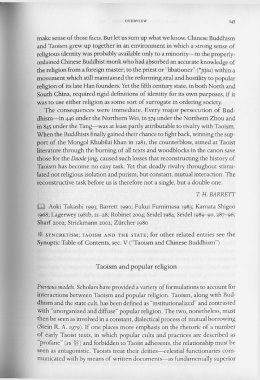Page 185 - The Encyclopedia of Taoism v1_A-L
P. 185
OVERVI EW 145
make sense of those facts. But let us sum up what we know. Chinese Buddhism
and Taoism grew up together in an environment in which a strong sense of
religious identity was probably available only to a minority-to the properly-
ordained Chinese Buddhist monk who had absorbed an accurate knowledge of
the religion from a foreign master; to the priest or "libationer" (*jijiu) within a
movement which still maintained the reforming zeal and hostility to popular
religion of its late Han founders. Yet the fifth century state, in both North and
South China, required rigid definitions of identity for its own purposes, if it
was to use either religion as some sort of surrogate in ordering society.
The consequences were immediate. Every major persecution of Bud-
dhism-in 446 under the Northern Wei, in 574 under the Northern Zhou and
in 845 under the Tang-was at least partly attributable to rivalry with Taoism.
When the Buddhists finally gained their chance to fight back, winning the sup-
port of the Mongol Khubilai khan in 1281, the counterblow, aimed at Taoist
literature through the burning of all texts and woodblocks in the canon save
those for the Daode jing, caused such losses that reconstructing the history of
Taoism has become no easy task. Yet that deadly rivalry throughout stimu-
lated not religious isolation and purism, but constant, mutual interaction. The
reconstructive task before us is therefore not a single, but a double one.
T. H. BARRETT
m Aoki Takashi 1993; Barrett 1990; Fukui Fumimasa 1983; Kamata Shigeo
1968; Lagerwey I98Ib, 21-28; Robinet 2004; Seidel 1984; Seidel 1989-90, 287- 96;
Sharf 2002; Strickmann 2002; Ziircher 1980
;;:::: SYNCRETISM; TAOISM AND THE STATE; for other related entries see the
Synoptic Table of Contents, sec. V ('Taoism and Chinese Buddhism")
Taoism and popular religion
Previous models. Scholars have provided a variety of formulations to account for
interactions between Taoism and popular religion. Taoism, along with Bud-
dhism and the state cult, has been defined as "institutionalized" and contrasted
with "unorganized and diffuse" popular religion. The two, nonetheless, must
then be seen as involved in a constant, dialectical process of mutual borrowing
(Stein R. A. 1979). If one places more emphasis on the rhetoric of a number
of early Taoist texts, in which popular cults and practices are described as
"profane" (su 1~) and forbidden to Taoist adherents, the relationship must be
seen as antagonistic. Taoists treat their deities- celestial functionaries com-
municated with by means of written documents- as fundamentally superior

